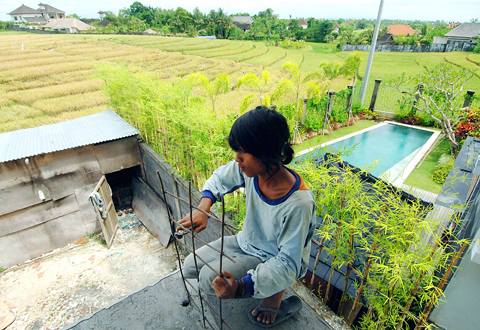Snatching a quick rest from a day of back-breaking work, Balinese rice farmer I Gusti Made Sukadana contemplates the gray-walled villas crowding the edges of his paddy field.
The villas are part of the latest building boom on the famous Indonesian holiday island, where homes for wealthy holidaymakers and expatriates are mushrooming across the bottle-green landscape.
Some see the growth of the villas as a boon. Others such as Sukadana, who toils not far from a beach favored by expats, see a threat to a way of life that stretches back hundreds of years.

PHOTO: AFP
“Farmers are working harder now but we’re earning less. Our major problem is a lack of water,” the weather-beaten 44-year-old said.
“Concrete buildings are everywhere, blocking irrigation. When it rains, the water flows to the beach instead of being absorbed through the soil,” he said.
“I think mine will be the last generation in Bali working the rice fields,” he said.
While Bali is no stranger to hotels, at both the high and low end of the market, the fad for villas — many with open-plan design and swimming pools in huge gardens — is relatively new.
Developers say they are seeing very little impact from the global economic woes.
Land sales and construction of luxury villas have increased 30 percent every year since 2003, mainly because of demand from Western Europeans and Asians, said Hera Heronika of construction company Bali Property.
“They usually come here during winter and rent out their villas for high prices when they are away,” Heronika said.
The trend is driven by foreigners moving toward quieter parts of the island to be close to nature — and Bali’s unique Hindu village culture — and away from well-worn tourist traps such as southern Bali’s storied Kuta beach.
“They like the rice fields and a view of the beach. Even with the global economic crisis, we continue to receive a lot of requests,” Bali Villa Rentals Association board member Dharma Putra said.
Rent for a top-end villa complete with swimming pool, maid service, gym and private cook can vary from US$500 a night to as much as US$2,500, he said.
But activists said the villa fad comes with other costs to the island.
Between 600 and 1,000 hectares of “green space” disappears beneath concrete in readiness for villa construction every year, especially those areas surrounding the tourist center hub on the island’s south, Friends of the Earth Indonesia campaigner Agung Wardana said.
The trigger for the explosive growth of the villas was national political reforms passed in the last decade that gave more power to local and provincial governments, allowing the spread of large-scale tourist developments in previously restricted areas, Wardana said.
“It’s like a cancer that spread out very quickly,” he said.
The main environmental problem is one of water. More buildings mean less land to absorb floodwater, leading to the inundation of low-lying areas.
Meanwhile, increasing water use by swimming pools and paved-over land disrupt the intricate irrigation system that waters the famous rice terraces that spread from Bali’s volcanic interior to the seaside.
“Bali is a small island. If this villa development continues, it’s not impossible that in 15 years Bali will be abandoned by tourists,” Wardana said.
Adding to the squeeze is the fact that the demand for villas is pushing up property prices and with them, land taxes, he said. This leaves farmers with ever-decreasing incomes.
In some parts of Badung district, where Sukadana farms, the land tax has doubled annually in recent years, Wardana said.
But Chandra Kirana, the owner of Bali Property, said farmers too can share in the boom.
“As demand increases, the price of land goes up and local people benefit. They can sell their land at a high price and buy cheap land somewhere else,” he said.

Kehinde Sanni spends his days smoothing out dents and repainting scratched bumpers in a modest autobody shop in Lagos. He has never left Nigeria, yet he speaks glowingly of Burkina Faso military leader Ibrahim Traore. “Nigeria needs someone like Ibrahim Traore of Burkina Faso. He is doing well for his country,” Sanni said. His admiration is shaped by a steady stream of viral videos, memes and social media posts — many misleading or outright false — portraying Traore as a fearless reformer who defied Western powers and reclaimed his country’s dignity. The Burkinabe strongman swept into power following a coup in September 2022

‘FRAGMENTING’: British politics have for a long time been dominated by the Labor Party and the Tories, but polls suggest that Reform now poses a significant challenge Hard-right upstarts Reform UK snatched a parliamentary seat from British Prime Minister Keir Starmer’s Labor Party yesterday in local elections that dealt a blow to the UK’s two establishment parties. Reform, led by anti-immigrant firebrand Nigel Farage, won the by-election in Runcorn and Helsby in northwest England by just six votes, as it picked up gains in other localities, including one mayoralty. The group’s strong showing continues momentum it built up at last year’s general election and appears to confirm a trend that the UK is entering an era of multi-party politics. “For the movement, for the party it’s a very, very big

ENTERTAINMENT: Rio officials have a history of organizing massive concerts on Copacabana Beach, with Madonna’s show drawing about 1.6 million fans last year Lady Gaga on Saturday night gave a free concert in front of 2 million fans who poured onto Copacabana Beach in Rio de Janeiro for the biggest show of her career. “Tonight, we’re making history... Thank you for making history with me,” Lady Gaga told a screaming crowd. The Mother Monster, as she is known, started the show at about 10:10pm local time with her 2011 song Bloody Mary. Cries of joy rose from the tightly packed fans who sang and danced shoulder-to-shoulder on the vast stretch of sand. Concert organizers said 2.1 million people attended the show. Lady Gaga

SUPPORT: The Australian prime minister promised to back Kyiv against Russia’s invasion, saying: ‘That’s my government’s position. It was yesterday. It still is’ Left-leaning Australian Prime Minister Anthony Albanese yesterday basked in his landslide election win, promising a “disciplined, orderly” government to confront cost-of-living pain and tariff turmoil. People clapped as the 62-year-old and his fiancee, Jodie Haydon, who visited his old inner Sydney haunt, Cafe Italia, surrounded by a crowd of jostling photographers and journalists. Albanese’s Labor Party is on course to win at least 83 seats in the 150-member parliament, partial results showed. Opposition leader Peter Dutton’s conservative Liberal-National coalition had just 38 seats, and other parties 12. Another 17 seats were still in doubt. “We will be a disciplined, orderly